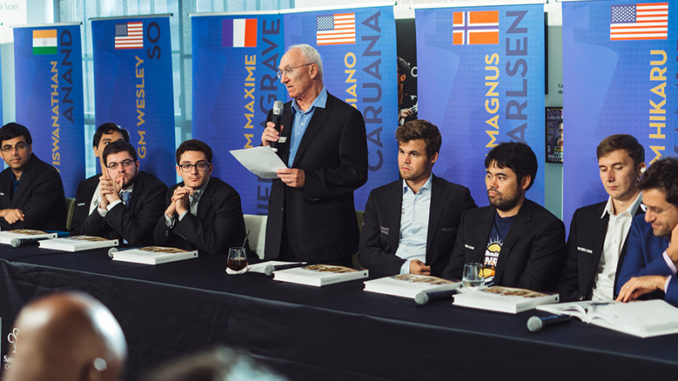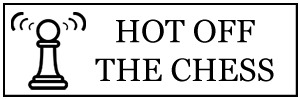
Round two of the Sinquefield Cup 2018 was played on Sunday 19th August. The round belonged to Magnus Carlsen. Taking on Sergey Karjakin, the World Champion achieved the only full point of the round against his former challenger.
He did it in quite some style too. Playing White, Magnus chose the English Opening and they followed a line that Karjakin knows quite well, having also played it as Black against Moiseenko and Aronian. Carlsen’s 13.dxc5 was a novelty, 13.Qxc4 having been the way to go up to this game.
For me, the first notable moment is after Carlsen’s 18.Qc2. The position is shown in the diagram, below. One thing that this move does, is prevent Black from developing his bishop to f5. Here, Karjakin played 18…Qe7, which I feel is a little slack compared to …Bh3. Grandmaster Robert Hess differs with this opinion, though. Analysing the game for chess.com, he said that the move, “…isn’t particularly threatening, since White has no real need to castle.” He gives 19.f3 and then Kf2 at some point.
As an untitled peasant, I am always reluctant to differ with masters, but I do feel that this view is a little hasty. Firstly, if White has no need to castle, why then be playing f3 and Kf2? To develop the Rh1 of course. This can be done, however, in one move instead of two, by castling. With the added bonus of getting the King out of the middle of the board, which is not ‘un-open’. And without playing f2-f3, which as Hess points out, makes Bc3 “…less simple to play,” because of the weakened e3-square. With all due respect to Robert, it is these kind of considerations that we have to give our opponent in a game. If it makes them go one move out of their way, we are making our presence felt.
Anyway, the last word we give to Sergey, who ultimately agreed with Grandmaster Hess. Magnus, promptly castled. Sergey then played …Bh3. I find it a weird move order by Black, what about you?
Play led to Queens coming off the board rather quickly. This left an opposite coloured bishop endgame that I think Black would not be especially unhappy with. White was always going to be the better of the two, though. The reason for this is the Black pawns on c4 and d5, which were going to need the bishop’s cover on the a2-g8 diagonal. The bishop would go to e6 and then f7, as shown in the following diagram.
Here, Sergey had just played 36…Rb7 and was probably feeling that he had all of his i’s dotted and t’s crossed. A bit of shuffling about had gone on and the game seemed to be heading for a draw. Of course, in this tournament games are played under the ‘Sofia rules’ of technical draws only, but repetition from this position is not difficult — Bd4 Reb8, Bc3 Re8, etc.
Sergey was not the only one to be shocked when Magnus unleashed his 37.Rfxd5! This sacrificed the exchange of rook for bishop and pawn. The great thing about this decision, is that it is all about vision and judgement. It is a long term investment, rather than a knockout blow with an immediate return. Rather than the game winding down, it had barely got started.
There of course followed 37…Bxd5 38.Rxd5 Kg6 (? …Rc8) 39.Rc5 Rh8 40.Kg3 Rb6. With the time control made and having picked up another pawn, Magnus settled in for the long haul. During their 2016 World Championship Match, Karjakin had dubbed himself the ‘Minister of Defence’ — he was going to have to prove it.
And he did his very best. However, when Magnus Carlsen has anything above a dead draw and the bit between his teeth, things are never going to be easy. With a position from which it was going to be very hard (nigh impossible) for White to lose, but that demanded the utmost precision from Black to hold, the odds of converting were very promising.
Under constant pressure, the clock also became Karjakin’s enemy. One or two less than optimum moves started to appear and then the clanging blunder, 77…Kc6(??)
It has to be said that this is a very bad move and a big surprise that Karjakin went for it rather than moves like …Re1+ or …Re6. The flaw with …Kc6 is that Black gives control of the 6th rank on a plate. Positional awareness should have told Sergey that he could only afford to take his King to the 6th rank if he can block check’s with his rook. Not only is this because of the a6-pawn, but White’s e-pawn is in danger of starting to edge forward also. Even in time pressure, this is quite a serious mistake and Karjakin will be very disappointed because he was very close to a very nice hold.
As it was, Carlsen did not look back after this. He was soon netting the a6-pawn, leaving his opponent in the hopeless situation of King and rooks against King, bishop, rook and three pawns. On move 88, a whole 51 moves after the sacrifice, it was 1-0.
My congratulations to Magnus for this game. He was obviously very pleased and described it as a, “…throwback”. I’ll assume that is a good thing … ? I must say that it is good to see. He seems to be in very good spirits.
Felt punch-drunk after the 7-hour fight against Karjakin, and lurched over to eat pic.twitter.com/czVPR9gYw9
— Magnus Carlsen (@MagnusCarlsen) August 21, 2018
Ultimately, this result began with creativity, vision and confidence. It was decided by technique. It was a demonstration of the essence that is chess. It is easy to think, while watching along with engines, that our beautiful game is all about plus-minus evaluations. It is not though, is it? It is about understanding the goings-ons on the board better than the opponent. It is about causing them problems that have many options to solve. For when all is said and done, options are opportunities to err.
There are not many who are as capable of this as Magnus Carlsen. It is what makes him a formidable opponent and an absolute joy to watch. His reward for this game was to join Mamedyarov and Aronian at the top of the standings. Karjakin, by contrast, was left sitting at the bottom, yet to get anything on the board.
Standings after Round 2:
Mamedyarov, Carlsen, Aronian — 1.5
Grischuk, Caruana, Vachier-Lagrave, Anand, Nakamura — 1.0
So — 0.5
Karjakin — 0.0
Round Three (Monday 20th August, 13:00 local time): Aronian vs Carlsen, Mamedyarov vs Caruana, Vachier-Lagrave vs So, Nakamura vs Grischuk, Karjakin vs Anand.

